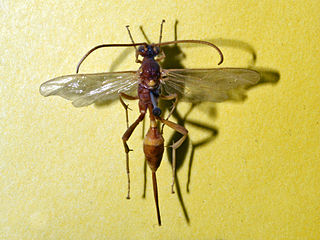
The Braconidae are a family of parasitoid wasps. After the closely related Ichneumonidae, braconids make up the second-largest family in the order Hymenoptera, with about 17,000 recognized species and many thousands more undescribed. One analysis estimated a total between 30,000 and 50,000, and another provided a narrower estimate between 42,000 and 43,000 species.
Labium is the Latin word for lip. In English, it may refer to:

The Leucospidae are a specialized group within the Chalcidoidea, composed exclusively of ectoparasitoids of aculeate wasps or bees. They are typically mimics of bees or stinging wasps, often black with yellow, red, or white markings, sometimes metallic, with a robust mesosoma and very strong sculpturing. The hind femora are often greatly enlarged, with a row of teeth or serrations along the lower margin as in Chalcididae. The female ovipositor is sometimes short, but if not, it is recurved and lies along the dorsal side of the metasoma, a unique feature. The males are also unusual, in the fusion of many of the metasomal segments to form a capsule-like "carapace".

Xoridinae are a worldwide subfamily of the parasitic wasp family Ichneumonidae.

The Metopiinae are a worldwide subfamily of the parasitic wasp family Ichneumonidae. Metopiinae are koinobiont endoparasitoids of Lepidoptera. There are 26 extant genera. A bulging shield-like face is diagnostic for members of this subfamily, but many members lack this character.

Ichneumoninae is a worldwide subfamily of the parasitic wasp family Ichneumonidae.

Cremastinae is a worldwide subfamily of the parasitic wasp family Ichneumonidae.

A wasp is any insect of the order Hymenoptera and suborder Apocrita that is neither a bee nor an ant. The Apocrita have a common evolutionary ancestor and form a clade; wasps as a group do not form a clade, but are paraphyletic with respect to bees and ants.
Labenopimplinae are an extinct subfamily of the parasitic wasp family Ichneumonidae. Labenopimplinae are known from the Cenomanian of the Russian Far East and Turonian of Orapa, Botswana. The subfamily includes five genera with 13 species. The subfamily is highly polymorphic and combines features of the Labeninae and Pimplinae.

Pimpla are a worldwide genus of the parasitic wasp family Ichneumonidae.
Dolichomastix is the scientific name of two genera of organisms and may refer to:
Myrmarachne exasperans is a species of jumping spider found in southeast Asia. The species which was originally described in Java has also been recorded in Borneo, Palawan (Philippines) Vietnam and Bali, where the largest number of individuals have been recorded.

Anomalon cruentatum is a species of parasitoid wasps belonging to the family Ichneumonidae.

Acroricnus seductor is a species of wasps belonging to the family Ichneumonidae.
Lathrolestes ensator is a species of wasp in the family Ichneumonidae. it is a parasitoid of the apple sawfly Hoplocampa testudinea. Both insects are native to Europe, but the sawfly has been accidentally introduced into North America where it has become established. The larvae of the sawfly tunnel into developing apple fruitlets which later fall to the ground, where the larvae continue their development. The wasp parasitises the larvae and has been released in North America as part of a biological control programme for the sawfly.
Homotropus is a genus of wasps in the family Ichneumonidae.
Idiogramma is a genus of wasp. It is the only extant genus in the tribe Idiogrammatini.
Clistopyga crassicaudata is a species of ichneumon wasp in the family Ichneumonidae which was first described in 2018. It is found in Peru and was one of seven new species found in a narrow zone of vegetation between the Amazon rainforest and the Andes. It received attention in the news due to the size of the female stinger/ovipositor.












